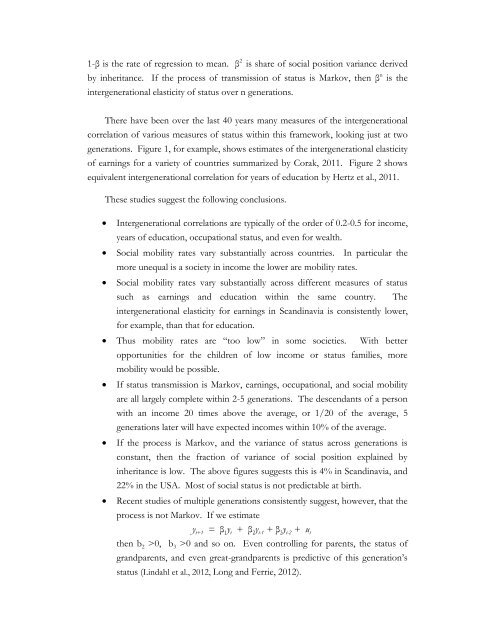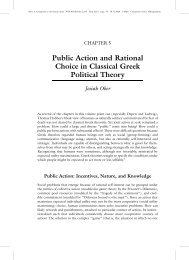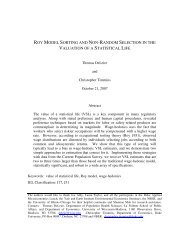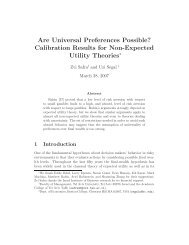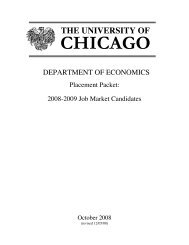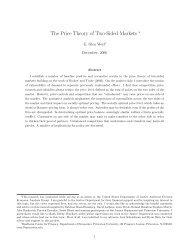Surnames and a Theory of Social Mobility - University of Chicago ...
Surnames and a Theory of Social Mobility - University of Chicago ...
Surnames and a Theory of Social Mobility - University of Chicago ...
You also want an ePaper? Increase the reach of your titles
YUMPU automatically turns print PDFs into web optimized ePapers that Google loves.
1-β is the rate <strong>of</strong> regression to mean. β 2 is share <strong>of</strong> social position variance derived<br />
by inheritance. If the process <strong>of</strong> transmission <strong>of</strong> status is Markov, then β n is the<br />
intergenerational elasticity <strong>of</strong> status over n generations.<br />
There have been over the last 40 years many measures <strong>of</strong> the intergenerational<br />
correlation <strong>of</strong> various measures <strong>of</strong> status within this framework, looking just at two<br />
generations. Figure 1, for example, shows estimates <strong>of</strong> the intergenerational elasticity<br />
<strong>of</strong> earnings for a variety <strong>of</strong> countries summarized by Corak, 2011. Figure 2 shows<br />
equivalent intergenerational correlation for years <strong>of</strong> education by Hertz et al., 2011.<br />
<br />
<br />
<br />
These studies suggest the following conclusions.<br />
Intergenerational correlations are typically <strong>of</strong> the order <strong>of</strong> 0.2-0.5 for income,<br />
years <strong>of</strong> education, occupational status, <strong>and</strong> even for wealth.<br />
<strong>Social</strong> mobility rates vary substantially across countries. In particular the<br />
more unequal is a society in income the lower are mobility rates.<br />
<strong>Social</strong> mobility rates vary substantially across different measures <strong>of</strong> status<br />
such as earnings <strong>and</strong> education within the same country.<br />
The<br />
intergenerational elasticity for earnings in Sc<strong>and</strong>inavia is consistently lower,<br />
for example, than that for education.<br />
Thus mobility rates are “too low” in some societies. With better<br />
<br />
<br />
<br />
opportunities for the children <strong>of</strong> low income or status families, more<br />
mobility would be possible.<br />
If status transmission is Markov, earnings, occupational, <strong>and</strong> social mobility<br />
are all largely complete within 2-5 generations. The descendants <strong>of</strong> a person<br />
with an income 20 times above the average, or 1/20 <strong>of</strong> the average, 5<br />
generations later will have expected incomes within 10% <strong>of</strong> the average.<br />
If the process is Markov, <strong>and</strong> the variance <strong>of</strong> status across generations is<br />
constant, then the fraction <strong>of</strong> variance <strong>of</strong> social position explained by<br />
inheritance is low. The above figures suggests this is 4% in Sc<strong>and</strong>inavia, <strong>and</strong><br />
22% in the USA. Most <strong>of</strong> social status is not predictable at birth.<br />
Recent studies <strong>of</strong> multiple generations consistently suggest, however, that the<br />
process is not Markov. If we estimate<br />
y t+1 = β 1 y t + β 2 y t-1 + β 3 y t-2 + u t<br />
then b 2 >0, b 3 >0 <strong>and</strong> so on. Even controlling for parents, the status <strong>of</strong><br />
gr<strong>and</strong>parents, <strong>and</strong> even great-gr<strong>and</strong>parents is predictive <strong>of</strong> this generation’s<br />
status (Lindahl et al., 2012, Long <strong>and</strong> Ferrie, 2012).


